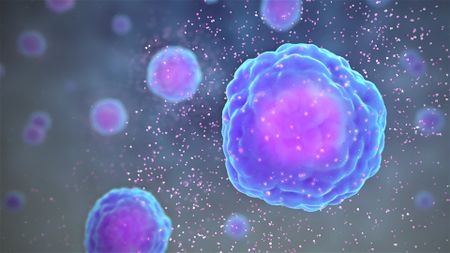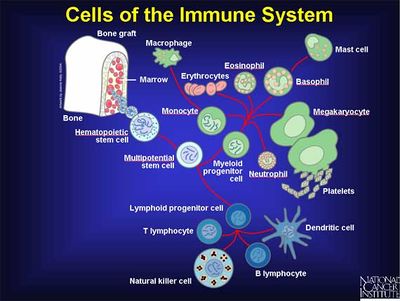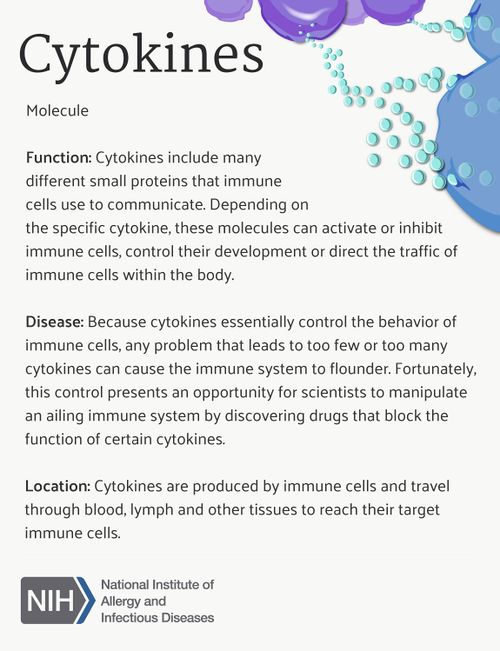Cytokines
Original Editor - Lucinda hampton
Top Contributors - Lucinda hampton, Kim Jackson and Nupur Smit Shah
Introduction[edit | edit source]
Cytokines are the unsung heroes of the immune system, often acting as the first responders to a pathogen infection.
Image: 3D medical animation still showing secretion of Cytokines
Cytokines are a group of proteins made by the immune system. Your immune cells use cytokines to communicate (acting as chemical messengers). Cytokines released from one cell affect the actions of other cells by binding to receptors on their surface. The receptors receive the cytokine's chemical message, and then the receiving cell performs activities based on that message. They:
- Stimulate the production of blood cells
- Aid in the development, maintenance, and repair of tissues
- Regulate the immune system
- Drive inflammation through interferons, interleukins, and tumor necrosis factor-alpha (TNFα)
The two principal producers of cytokines are helper T cells (Th cells) and macrophages, although they can be transiently induced and secreted by virtually all nucleated cells.
- Proinflammatory cytokines play a role in the development of inflammatory and neuropathic pain.
- Anti-inflammatory cytokines are actually inflammatory cytokine antagonists.[1][2][3][4].
Action and Function[edit | edit source]
When a pathogen enters the body, immune cells, cytokines and organs respond by working together.
Cytokines work by signal transduction.
- Each cytokine has a matching cell-surface receptor.
- Then cascades of signals inside the cell changes cell functions.
- This may include the regulation of several genes, the production of other cytokines, or an increase in surface receptors for other molecules.
On the basis of functions, they can have three biological actions:
- Mediators and regulators of innate immunity: are produced mainly by mono-nuclear phagocytes in response to infectious agents.
- Mediators and regulatory of adaptive immunity: are produced mainly by T lymphocytes in response to specific recognition of foreign antigens.
- Stimulators of hematopoiesis: are produced by bone marrow stromal cells, leukocytes, and other cells, and stimulate the growth and differentiation of immature leukocytes[5].
Types of Cytokines[edit | edit source]
- Cytokine is an umbrella term that includes all kinds, more specific names are given to cytokines based on either the type of cell that makes them or the action they have in the body.
- These small signaling molecules are produced by many different immune cells, such as neutrophils (some of the first cells to travel to an infection site), mast cells (responsible for allergic reactions), macrophages, B-cells and T-cells,[6]
- Below are some of the more common classifications.
Lymphokines[edit | edit source]
Lymphokines are cytokines that are produced by lymphocytes, hence the name. Lymphocytes are white blood cells that either produce antibodies (B lymphocytes) or directly attack invaders (T lymphocytes). These lymphocytes produce lymphokines that function as messengers, sending signals out to other cells, such as macrophages and other lymphocytes, telling them to come in and help out with the infected area.
Interferons[edit | edit source]
Interferons are proteins that inhibit viruses from replicating. If a cell gets invaded by a virus, it releases interferons. This signals other cells to put up their shields so the virus does not spread. So, interferons interfere with the spread of a virus. Interferons also activate natural killer T-cells. These cells further the fight against the virus by destroying infected cells.
Interleukins[edit | edit source]
Interleukins are proteins that regulate immune and inflammatory responses. They are produced mainly by white blood cells. Their job is to send signals out to other white blood cells telling them they need to report for duty. The name interleukins is easy recall as inter means between cells, and the second part, 'leukins,' refers to leukocytes. So, interleukins create communication between leukocytes. There are many different types of interleukins, and each has a role to play in the immune system. These functions include the growth, maturation and activation of immune cells.
Tumor Necrosis Factor (TNF)[edit | edit source]
Tumor necrosis factor, or TNF, is a type of cytokines that can destroy cells, including cancer cells. TNF is produced by different cells, but mainly by macrophages. When it's released, it can bind to cancer cells and cause their destruction.
Chemokines[edit | edit source]
Chemokines are a type of cytokines that call in cells to the site of infection. The ability to call in other cells using a chemical message is a process referred to as chemotaxis. This fact shows us how this type of cytokine gets its name; chemokines induce chemotaxis. Chemokines are the coordinators of the battle. Eg, when a foreign substance is detected, chemical orders are sent out to immune cells, including various white blood cells. These cells then travel toward the area to eliminate the threat[3].
Pharmaceutical Use[edit | edit source]
Cytokines play a broad role to help the immune system respond to diseases, and drugs which modulate their effect have led to some amazing therapies. Cytokines may be "good" when stimulating the immune system to fight a foreign pathogen or attack tumors. Other "good" cytokine effects include reduction of an immune response eg interferon β reduction of neuron inflammation in patients with multiple sclerosis. They may be "bad" when their expression causes inflammatory diseases eg the role of tumor necrosis factor α in rheumatoid arthritis or asthma and Crohn's disease. Therapeutic modulation of cytokine expression can help the "good" cytokines to generate or quench the immune system and block the "bad" cytokines to prevent damaging inflammatory events[7].
Cytokine Storm[edit | edit source]
A Cytokine Storm is an overreaction of the immune system, in which an excess of cytokines triggers an onslaught of white blood cells that swarm an infected area of the body, resulting in inflammation, possible tissue damage, and in extreme cases, organ failure:
Devastating lung inflammation triggered by the so-called 'cytokine storm' is thought to be what ultimately kills the sickest coronavirus patients[8].
References[edit | edit source]
- ↑ Immunology org. Cytokines Available from: https://www.immunology.org/public-information/bitesized-immunology/receptors-and-molecules/cytokines-introduction (accessed 12.1.2021)
- ↑ SinobiologyCytokines Available from:https://www.sinobiological.com/resource/cytokines/cytokine-function (accessed 12.1.2021)
- ↑ 3.0 3.1 Study academy Cytokines Available from:https://study.com/academy/lesson/what-are-cytokines-definition-types-function.html (accessed 12.1.2021)
- ↑ Very well health Cytokines Available from:https://www.verywellhealth.com/what-are-cytokines-189894 (accessed 12.1.2021)
- ↑ Microbiol notes Cytokines Avaliabe from: https://microbenotes.com/cytokines-mechanism-of-action-and-functions/ (accessed 12.1.2021)
- ↑ LIve science https://www.livescience.com/what-are-cytokines.html Available from:https://www.livescience.com/what-are-cytokines.html (accessed 12.1.2021)
- ↑ Ramani T, Auletta CS, Weinstock D, Mounho-Zamora B, Ryan PC, Salcedo TW, Bannish G. Cytokines: the good, the bad, and the deadly. International Journal of Toxicology. 2015 Jul;34(4):355-65.Available from:https://pubmed.ncbi.nlm.nih.gov/26015504/ (accessed 12.1.2021)
- ↑ Health Cytokine storm Available from:https://www.health.com/condition/infectious-diseases/coronavirus/cytokine-storm (accessed 12.1.2021)









